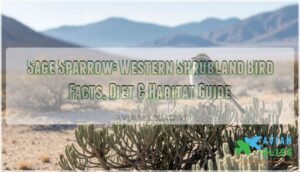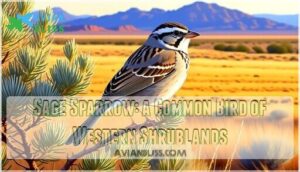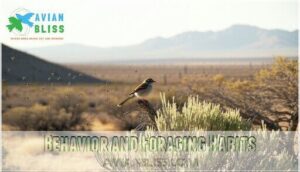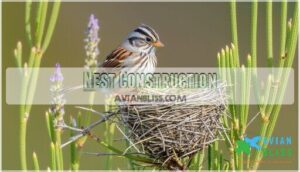This site is supported by our readers. We may earn a commission, at no cost to you, if you purchase through links.

This compact 5-6 inch bird sports soft gray upperparts, white underparts, and a distinctive dark breast spot that makes identification easy.
They’re ground foragers who prefer open spaces beneath shrub canopies, switching from insects during breeding season to energy-rich seeds in winter.
Males deliver bell-like calls and complex songs lasting about two seconds, maintaining one song type their entire lives.
These sagebrush specialists need large, intact habitat areas to thrive, making them vulnerable to habitat fragmentation and climate change.
Their breeding territories span 2-13 acres, and they show remarkable site fidelity, returning to identical locations year after year.
Understanding their specific habitat needs reveals why protecting continuous sagebrush landscapes matters more than you might expect.
Table Of Contents
- Key Takeaways
- Sage Sparrow: a Common Bird of Western Shrublands
- Geographic Range and Distribution
- Behavior and Foraging Habits
- Nesting and Reproduction
- Diet and Feeding Patterns
- Conservation Status and Threats
- Frequently Asked Questions (FAQs)
- What is a sage sparrow?
- What is a sagebrush sparrow?
- Where does the sagebrush sparrow live?
- Are sagebrush sparrows declining?
- What does a Sagebrush Sparrow eat?
- What is the difference between Bell Sparrow and sagebrush?
- What are some interesting facts about Sage sparrows?
- What is the rarest type of sparrow?
- Where do sage sparrows live?
- What do sage sparrows eat?
- Conclusion
Key Takeaways
- You’ll easily identify sage sparrows by their gray plumage, white eye-ring, and dark breast spot – plus their signature tail-up hopping behavior that makes them stand out in sagebrush habitats.
- These birds are dietary specialists who switch seasonally – they’ll hunt protein-rich insects during breeding season to feed their young, then shift to energy-dense seeds during harsh winter months.
- You’re watching a species that’s extremely habitat-dependent – sage sparrows need large, continuous sagebrush areas (2-13 acres per territory) and show remarkable site fidelity by returning to identical locations year after year.
- Their survival faces serious threats from human activities – with only 56% of original sagebrush habitat remaining due to fragmentation, overgrazing, invasive species, and climate change impacts that reduce breeding success by 25% during heat waves.
Sage Sparrow: a Common Bird of Western Shrublands
You’ll recognize the Sage Sparrow by its elegant gray plumage, distinctive white eye-ring, and the dark spot adorning its chest as it hops through sagebrush with its tail characteristically cocked upward.
A master of desert disguise, this tail-cocking sparrow thrives where sagebrush meets sky
This unassuming bird has mastered life in the American West’s arid shrublands, where it blends seamlessly into the muted colors of its sagebrush habitat.
Physical Description
The beauty of sage sparrow identification lies in recognizing its understated elegance.
You’ll spot this compact bird measuring 5-6 inches with distinctive plumage coloration featuring soft gray upperparts and crisp white underparts.
Its eye-ring distinctiveness creates a striking white circle around dark eyes, while the prominent breast spot marks its chest center.
The tail length appears proportionally longer than most sparrows, and sexual dimorphism remains minimal between males and females.
Key identification features include:
- White eye-ring and whisker stripe – Creates facial contrast against gray head
- Dark central breast spot – Distinctive marking on otherwise pale underparts
- Brownish wing patches – Contrasts with overall gray plumage
- Proportionally long tail – Aids flight maneuvers through dense shrubland
Habitat Preferences
You’ll find sage sparrows thriving in sagebrush habitats across the American West, where sagebrush density creates perfect cover for these desert birds.
They prefer elevations below 5,600 feet in the arid environment of the Great Basin.
During breeding season, they stick to intact sage tracts, but winter habitats expand to include saltbush scrub and desert grasslands.
Habitat fragmentation threatens these specialized birds, as they need large, continuous areas of sagebrush, and the soil composition of their preferred areas typically supports big sagebrush stands that provide both nesting sites and foraging opportunities.
Geographic Range and Distribution
You’ll find Sagebrush Sparrows across the arid interior West, from the Great Basin’s sagebrush flats to the desert scrublands where they spend their winters.
These birds stick to a predictable pattern, breeding in the mountain West’s shrubby country and migrating south to Mexico’s northern deserts when cold weather arrives, following a predictable pattern and migrating to Mexico’s northern deserts.
Breeding Areas
During breeding season, Sage Sparrows establish territories across the interior western United States, from the Great Basin to intermountain regions.
These birds claim territory sizes ranging from 2-13 acres in sagebrush-dominated landscapes below 5,600 feet nesting elevation.
They show remarkable breeding fidelity, returning to identical locations annually.
Nesting occurs in low shrubs, typically 30-50 centimeters above ground.
Females lay clutch sizes of 3-4 eggs between March and July.
Incubation lasts approximately two weeks, with nesting success heavily dependent on habitat quality and predator presence.
Nestlings fledge after developing in these carefully selected sagebrush strongholds.
Wintering Grounds
When breeding season ends, sage sparrows head south to their wintering grounds in desert scrub and grasslands across the Southwest and northern Mexico.
These winter habitats offer essential resources during harsh months. Bird migration patterns show they’re remarkably loyal, returning to the same spots annually.
Food availability drives their location choices—they seek areas rich in seeds and insects. Survival rates depend on finding quality sagebrush habitat that provides shelter and sustenance.
These important areas are also key stopover sites for migratory birds. Conservation challenges intensify as climate change threatens these important refuges, making habitat protection increasingly important for maintaining healthy populations.
Behavior and Foraging Habits
You’ll notice Sagebrush Sparrows spend most of their time hopping and running along the ground with their tails cocked upward, a distinctive behavior that makes them easy to spot among the sage.
Their trilling songs and sharp "tink" calls echo across the shrublands as they communicate with mates and defend their surprisingly large territories from other sparrows, which is a key aspect of their surprisingly large territories.
Ground Foraging Techniques
You’ll watch sage sparrows master ground foraging with their signature tail-up posture.
These birds walk and hop through sagebrush, preferring to run between shrubs rather than fly when startled.
Their substrate preferences include open ground beneath shrub canopies where insect detection proves most successful.
Seed dispersal areas become prime hunting grounds, while dense vegetation provides predator avoidance.
Smart energy expenditure keeps them close to shrub bases, maximizing foraging efficiency while staying protected in their harsh desert home.
Their nests are typically placed in low shrubs, often sagebrush or saltbush, less than four feet above the ground.
Vocalizations and Singing Patterns
While ground foraging, you’ll hear Sagebrush Sparrows’ distinctive vocalizations echoing through the shrublands.
Males produce bell-like calls and complex bird songs lasting 1.7-2 seconds during breeding season. Each male maintains one stereotyped song type throughout his lifetime, delivering 8-10 songs per minute.
Their Call Repertoire includes soft tink notes for contact communication, while Song Complexity varies among populations, creating Regional Dialects within neighborhoods. Modern genetic sequencing even supports the distinct species status of some subspecies.
Vocalizations that’ll capture your heart:
- Males sing from shrub tops at dawn, creating a natural Dawn Chorus
- Bell-like calls serve as gentle contact notes between mates
- Unique singing patterns remain unchanged for life
- Local song clusters form Regional Dialects among neighboring males
Nesting and Reproduction
When you’re ready to learn about sage sparrow families, you’ll discover these birds create surprisingly sturdy homes in harsh desert conditions.
Their reproductive cycle perfectly matches the brief window when sagebrush ecosystems provide ideal nesting resources and food availability.
Nest Construction
Sage sparrows are meticulous nest builders who select prime real estate in their sagebrush habitat.
These birds construct cup-shaped nests using twigs, grasses, and bark strips as primary nest materials. Nest placement occurs low in shrubs, typically 12-18 inches above ground, providing protection from predators while remaining accessible.
The nest dimensions measure approximately 3 inches across with walls about 2 inches deep. During nest construction, pairs work together over 3-4 days, carefully weaving materials into a sturdy foundation.
They line the interior with soft feathers, animal fur, or fine grasses for insulation. Birds may require specific nesting products to complete their nests.
Nest reuse is uncommon, as sage sparrows typically build fresh structures each breeding season in their nesting territory.
Egg Laying and Incubation
Following successful nest construction, female Sage Sparrows begin their egg-laying process from early April through mid-June.
You’ll observe clutch sizes ranging from 1-4 eggs, typically containing 3 pale blue specimens with brown speckles.
The incubation period spans 13-14 days, with females primarily handling incubation duties while males guard territories.
Egg coloration provides camouflage within sagebrush habitat.
Parental care intensifies during breeding season, ensuring hatching success through dedicated nesting behaviors.
Birds often select nest sites based on food availability factors.
Key reproductive factors include:
- Rainfall timing affects clutch initiation and breeding success
- Dense vegetation cover increases hatching success rates
- Both parents feed protein-rich insects to newly hatched young
Diet and Feeding Patterns
You’ll find that sage sparrows have adapted their eating habits to match the harsh realities of desert life, switching from protein-packed insects during breeding season to energy-rich seeds when raising young isn’t the priority.
These resourceful birds get most of their water from food rather than drinking, making them perfectly suited for their arid sagebrush homes, and have thus mastered the art of surviving with minimal water.
Seed Preferences
During nonbreeding months, you’ll find sage sparrows becoming incredibly choosy about their seeds.
Preferred species include inkweed, various sage plants, and native grasses.
Seed size matters – they target smaller varieties that match their bill dimensions perfectly.
Oil content becomes critical during harsh winters, providing essential energy reserves.
Seasonal availability drives their foraging patterns, with dense inkweed patches supporting the highest sparrow densities.
You can spot them methodically searching ground surfaces, skillfully cracking shells to access nutrient-rich kernels.
Their avian diet strategy focuses on energy-dense options rather than quantity, ensuring survival through challenging seasons.
Germination impact rarely concerns them since they consume seeds before sprouting occurs.
Many retailers offer specialty sage sparrow seed mixes.
Insect Consumption
During breeding season, insect nutrition becomes essential for Sage Sparrows, with adults consuming protein-rich prey to fuel reproduction and nestling growth.
Seasonal variation dramatically shifts their avian diet:
- Prey selection includes beetles, grasshoppers, spiders, and caterpillars
- Larval diet provides essential proteins for rapidly growing chicks
- Ground foraging techniques involve hopping and tail-twitching to flush insects
- Feeding behavior adapts to insect availability, ensuring foraging success
This dietary flexibility helps them thrive in harsh sagebrush environments. They utilize ground foraging, similar to other birds exhibiting ground feeding behaviors.
Conservation Status and Threats
While you’re observing these hardy sparrows in their sagebrush homes, you’re witnessing a species facing serious challenges from habitat destruction and climate shifts.
Unfortunately, only 56% of their native sagebrush ecosystem remains intact, threatening their survival across the American West, due to these significant environmental challenges.
Climate Change Impacts
Climate change delivers a one-two punch to Sage Sparrows through habitat shifts and extreme weather events.
You’ll find these birds struggling as their sagebrush habitat contracts by 30% in drought-stricken areas.
Breeding success plummets 25% during heat waves, while food availability drops as insect populations crash.
Water scarcity forces longer foraging times, weakening adults in their already challenging arid environment.
Conservation efforts are essential, as 78% of bird species face extinction due to these combined factors, making conservation crucial.
Habitat Loss Concerns
Habitat loss threatens sage sparrows more than any other factor.
You’ll witness devastating fragmentation effects as only 56% of original sagebrush habitat remains.
Overgrazing impact degrades shrub structure while invasive species like cheatgrass outcompete native plants.
Altered fire regimes prevent sagebrush recovery, and agricultural conversion destroys nesting sites.
Without effective conservation strategies, sage sparrows face continued habitat degradation.
Their conservation status depends on protecting large, unfragmented sagebrush tracts from further destruction.
Human activities cause significant bird declines globally.
Frequently Asked Questions (FAQs)
What is a sage sparrow?
You’ll find this small sparrow living in sagebrush ecosystems across the western United States.
It’s got distinctive gray plumage, a white eye-ring, and feeds on seeds and insects while blending perfectly into its shrubby habitat.
What is a sagebrush sparrow?
Like a gray ghost that blends seamlessly into silver sagebrush, you’ll find this small sparrow hopping across Western deserts, sporting distinctive white eye-rings and surviving on seeds and insects.
Where does the sagebrush sparrow live?
You’ll find sagebrush sparrows in the arid Western United States, particularly the Great Basin region.
They breed in sagebrush steppe between the Rockies and coastal ranges, then winter in southwestern deserts and northern Mexico.
Are sagebrush sparrows declining?
Picture a canary in a coal mine—when sagebrush sparrows struggle, their entire ecosystem’s in trouble.
Yes, you’re witnessing population declines as habitat loss destroys 44% of sagebrush lands, leaving these ground-dwelling birds fewer places to call home.
What does a Sagebrush Sparrow eat?
You’ll find Sagebrush Sparrows eating insects, spiders, seeds, small fruits, and succulent vegetation during breeding season, then switching primarily to seeds during winter months.
What is the difference between Bell Sparrow and sagebrush?
You’ll notice Bell’s Sparrow and Sagebrush Sparrow were actually one species until 2013, when scientists split them based on genetic differences, distinct songs, and separate habitats across the western United States.
What are some interesting facts about Sage sparrows?
You’ll discover Sagebrush Sparrows run with tails raised rather than flying when startled.
They’re desert survivors getting water from food, occupying some of North America’s largest sparrow territories in threatened sagebrush habitat.
What is the rarest type of sparrow?
Finding the world’s most elusive sparrow species isn’t straightforward—you’ll discover several contenders.
The Zapata Sparrow from Cuba’s wetlands claims this distinction, with fewer than 3,000 individuals remaining in fragmented habitat patches.
Where do sage sparrows live?
You’ll find these sparrows throughout the American West‘s sagebrush country, from the Great Basin to desert scrublands.
They breed between the Rockies and coastal ranges, then winter in southwestern states and northern Mexico.
What do sage sparrows eat?
You’ll discover these resourceful birds aren’t picky eaters.
They munch on insects, spiders, seeds, small fruits, and succulent plants during breeding season, then switch primarily to seeds in winter, getting water from their food.
Conclusion
Like a lighthouse standing guard over treacherous shores, the sage sparrow serves as a sentinel of western shrublands, its presence signaling healthy sagebrush ecosystems.
You’ve discovered how this resilient bird adapts its diet seasonally and maintains lifelong territory bonds.
However, the sage sparrow faces mounting pressures from habitat fragmentation and climate shifts.
Supporting conservation efforts that protect large, continuous sagebrush landscapes guarantees these distinctive ground-foragers continue their essential role in western ecosystems for generations to come, ensuring the sage sparrow remains a vital part of the ecosystem as a sentinel.









